Why this resume works
- Quantifies accomplishments: Measurable accomplishments like preparing over 30 anesthesia setups daily with zero delays showcase the applicant’s efficiency and reliability.
- Highlights industry-specific skills: With healthcare skills in anesthesia equipment management and patient monitoring systems, the applicant aligns closely with healthcare demands.
- Illustrates problem-solving ability: Reducing OR prep time by 10% through collaboration illustrates the applicant’s proactive problem-solving skills and initiative.
More Anesthesia Technician Resume Examples
Check out our anesthesia technician resume examples to understand how to showcase your technical skills, patient support experience, and teamwork abilities. These medical resume samples will help you create a resume that attracts healthcare employers.
Entry-Level Anesthesia Technician
Why this resume works
- Centers on academic background: By listing a master’s in health sciences and a bachelor’s in biology, the applicant’s education section shows a strong academic foundation relevant to early career stages.
- Effective use of keywords: Strategically using industry-specific keywords like “anesthesia administration” and “safety protocol implementation” optimizes the resume to pass ATS and stand out to hiring managers.
- Shows digital literacy: The resume showcases computer skills through medical technology utilization, reflecting preparedness for tech-driven healthcare settings.
Mid-Level Anesthesia Technician
Why this resume works
- Points to measurable outcomes: By reducing anesthesia inventory costs by 12% and streamlining equipment prep time by 15%, the applicant clearly shows their focus on efficiency and measurable outcomes.
- Demonstrates language abilities: Language skills in Spanish, French, and German support effective cross-cultural communication in healthcare settings.
- Displays technical expertise: Managing anesthesia setups and maintaining compliance with safety protocols highlight the applicant’s strong technical expertise essential for surgical environments.
Experienced Anesthesia Technician
Why this resume works
- Showcases impressive accomplishments: Showcasing a knack for strong results, the applicant’s role in saving $50,000 annually through streamlined anesthesia setups highlights substantial fiscal benefits.
- Sections are well-organized: The use of bullet points and headers transforms complex job responsibilities into easily digestible sections, enabling a seamless reading experience throughout the resume.
- Emphasizes leadership skills: By training over 50 staff members in new protocols, the applicant effectively demonstrates essential leadership skills that foster team development and procedural innovation.
Related Resume Guides
- Clinical Project Manager
- Clinical Research Assistant
- Clinical Trial Associate
- Coding Specialist
- Dermatologist
- Dialysis Technician
- Doctor
- Electrocardiograph Technician
- Emergency Department Technician
- Emergency Room Registration Clerk
- Equipment Technician
- Health Information Technician
- Hospital Administrator
- Hospital Volunteer
- Intake Coordinator
- Intensive Care Physician
- Medical Laboratory Technologist
- Medical Records Specialist
- Medical Representative
- Medical Research Assistant
- Midwife
- MRI Technologist
- Neurosurgeon
- Nuclear Medicine Technologist
- OB-GYN Medical Assistant
- Ophthalmologist
- Ophthalmology Assistant
- Optometrist
- Orthopedic Surgeon
- Pediatric Assistant
- Pediatrician
- Physician
- Physician Assistant
- Podiatrist
- Psychiatrist
- Radiologist
- Radiology Technician
- Resident Medical Officer
- Respiratory Therapist
- Speech Language Pathologist
- Surgeon
- Surgery Scheduler
- Ultrasound Technician
Advice for Writing Your Anesthesia Technician Resume
Discover essential advice on how to write a resume for an anesthesia technician role, and learn how to highlight your specialized skills and experience in the medical field.
Explore our tips to craft a standout resume tailored specifically for your profession, ensuring you present yourself as the best fit for any anesthesia technician position.
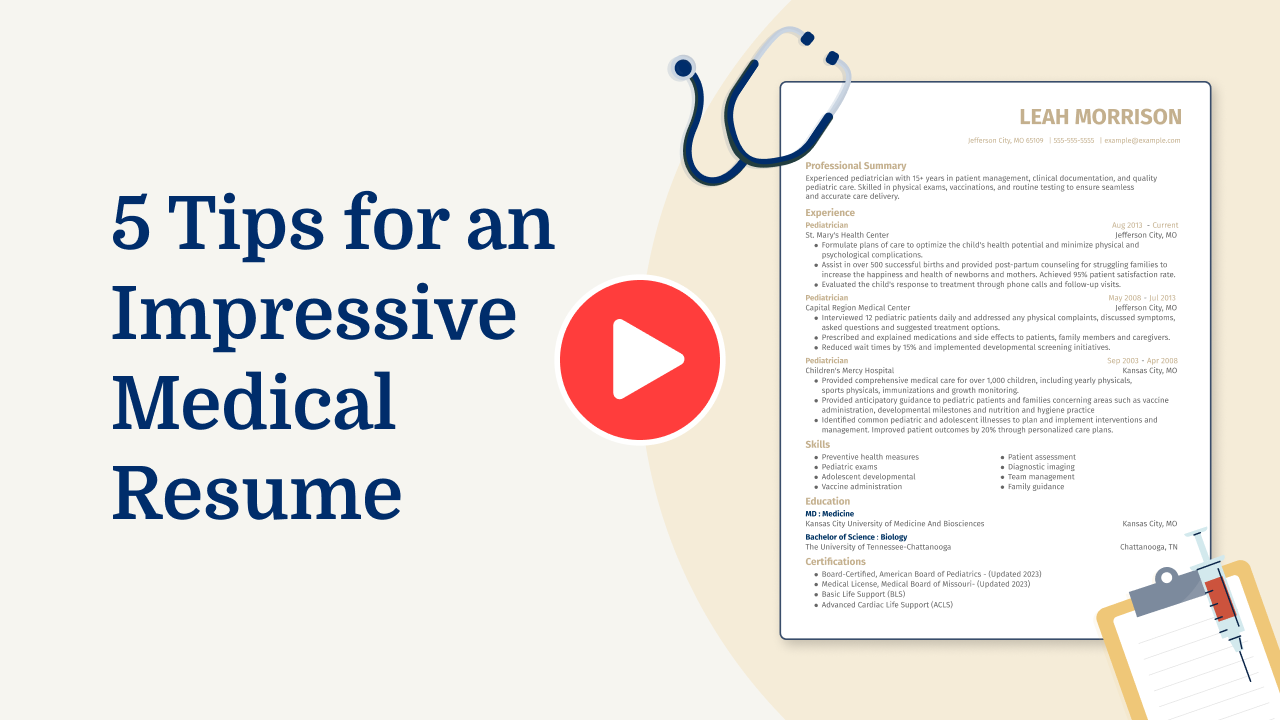
Write a strong professional summary
A professional summary serves as the opening of a resume, functioning like an introduction to hiring managers. It gives them insight into who you are and what you have to offer. When crafting a resume, you can choose between a summary or an objective, each serving distinct purposes.
Consisting of three to four sentences, a professional summary highlights your experience, skills, and achievements. It’s particularly beneficial for experienced applicants looking to emphasize their professional identity and value swiftly.
In contrast, resume objectives center on career goals and are ideal for entry-level applicants, career changers, or those with job gaps. They emphasize what you aim to contribute rather than past achievements.
Next, we will provide examples of both summaries and objectives tailored for various industries and experience levels, including one for an anesthesia technician role. See our library of resume examples for additional inspiration.
Anesthesia technician resume summary examples
Entry-level
Recent graduate with an associate degree in anesthesia technology, certified as an Anesthesia Technician (Cer.A.T.) and Basic Life Support (BLS). Completed clinical rotations at a major hospital, gaining foundational skills in anesthesia equipment setup and patient monitoring. Eager to contribute to surgical teams by ensuring safe and effective anesthesia care.
Mid-career
Anesthesia technician with over five years of experience supporting anesthesiologists in diverse healthcare settings, including hospitals and outpatient surgery centers. Proficient in preparing anesthesia machines, maintaining supply inventory, and assisting during intubation procedures. Recognized for strong attention to detail and ability to work efficiently under pressure.
Experienced
Highly experienced anesthesia technician with 10+ years in the field, specializing in pediatric and cardiac anesthesia support. Certified Anesthesia Technologist (Cer.A.T.T.) with advanced training in managing complex anesthesia delivery systems. Proven track record of mentoring junior staff and improving operating room efficiency through process improvements.
Anesthesia technician resume objective examples
Recent graduate
Eager and dedicated recent graduate from an accredited anesthesia technician program, seeking an entry-level position to apply acquired knowledge and technical skills in anesthetic procedures. Committed to supporting anesthesiologists and ensuring patient safety during surgical operations.
Career changer
Passionate healthcare worker transitioning into the role of anesthesia technician, bringing hands-on experience in patient care and a solid understanding of clinical environments. Excited to contribute to the anesthesia team by providing attentive assistance and maintaining high standards of care.
Specialized training
Certified anesthesia technician with specialized training in airway management and pharmacology, looking to join a forward-thinking medical facility. Driven to use advanced skills in assisting with anesthetic administration and monitoring patients throughout surgery, ensuring optimal outcomes.
Try our Resume Builder to make your anesthesia technician resume stand out. It offers easy-to-use templates that highlight your skills and experience.
Include relevant certifications and training
For an anesthesia technician, listing certifications and training shows you are ready for the job. In technical fields, having the right credentials proves you have learned specific skills needed to perform your duties safely and effectively.
Creating a certifications section on your resume helps employers quickly see what qualifications you have. Here are a few examples of relevant certifications for your resume:
- Certified Anesthesia Technician (CerAT)
- Basic Life Support (BLS) Certification
- Advanced Cardiovascular Life Support (ACLS) Certification
- National Anesthesia Tech Certification Exam
- Pediatric Advanced Life Support (PALS) Certification
Having these certifications makes it clear that you’re trained in key areas that make a difference in patient care. It builds trust with potential employers who need assurance about your skills. Showcasing these credentials boosts your chances of standing out as a knowledgeable anesthesia technician.
Example of a certifications section
Certified Anesthesia Technician (Cer.A.T.)
Issued by: American Society of Anesthesia Technologists and Technicians (ASATT)
Issued 2021
Basic Life Support (BLS) Certification
Issued by: American Heart Association
Expires 2024
Advanced Cardiovascular Life Support (ACLS) Certification
Issued by: American Heart Association
Expires 2023
Choose a polished and well-organized resume template that effectively showcases your skills and qualifications to stand out to hiring managers in your field.
Showcase your work experience
Including relevant work experience on your resume is key because it shows employers what you have done and how you’ve contributed in past roles. For an anesthesia technician, it’s important to highlight experiences that demonstrate your skills in assisting with anesthesia procedures.
List your work experience, starting with the most recent job and working backward. Include details like your job title, employer’s name, location, and employment dates for each position to help employers quickly see where you’ve worked and the roles you’ve held.
Use action words to effectively describe tasks related to being an anesthesia technician, such as organizing equipment efficiently or maintaining a sterile environment. Whenever possible, include numbers or specific outcomes to illustrate how your work made a difference; for example, mention reducing setup time or improving patient care through consistent monitoring of vital signs.
Highlight core responsibilities like assisting anesthesiologists during surgeries and managing anesthesia supplies while calibrating equipment or troubleshooting technical issues. These details will paint a clearer picture of your capabilities and readiness for the role of an anesthesia technician. By doing so, you’ll give potential employers a strong sense of what you can contribute to their team.
5 anesthesia technician work history bullet points
- Assisted anesthesiologists in the preparation and administration of anesthesia, improving patient readiness time by 15%.
- Maintained and calibrated anesthesia equipment, reducing device malfunction incidents by 25% through regular checks.
- Managed inventory for anesthetic supplies, decreasing supply shortages by 30% with efficient stock monitoring.
- Trained junior technicians on standard operating procedures, improving team performance by 20%.
- Streamlined patient data entry processes, cutting documentation errors by 40% through the implementation of digital systems.
For anesthesia technicians, choose a resume format that highlights your technical skills, certifications, and experience working in surgical or clinical settings.
Match your resume with the job description
Tailoring your resume to fit the job description is important because it helps you stand out to employers and ensures your resume passes through applicant tracking systems (ATS). ATS tools scan resumes for specific keywords and phrases from job postings, making it essential to match these terms closely.
An ATS-friendly resume includes relevant keywords and phrases that align with your skills. By doing this, you increase your chances of being noticed by hiring managers who are looking for specific qualifications related to the position, such as an anesthesia technician.
To identify keywords from anesthesiologist technician job postings, pay close attention to the skills, qualifications, and responsibilities that appear frequently.
Common examples might include “patient monitoring,” “anesthesia equipment setup,” “sterile techniques,” or “supporting anesthesiologists during procedures.” Using these exact phrases in your resume can help your application stand out to both hiring managers and ATS.
Incorporate these terms naturally into your resume by weaving them into your experience descriptions. For example, if a posting highlights “assisting with anesthesia administration,” you could write “assisted anesthesiologists with safe and efficient anesthesia administration during surgical procedures.” This approach shows you’ve performed the tasks they’re looking for without simply copying the job posting.
It’s also important to customize your resume for each application by adjusting keywords and phrasing to reflect the specific requirements of that role. Doing so demonstrates attention to detail and ensures your resume speaks directly to what the employer needs.
Want your resume to pass through applicant tracking systems? Try our ATS Resume Checker to find common problems and get tips on how to make your resume better.
FAQ
Do I need to include a cover letter with my anesthesia technician resume?
Yes, including a well-crafted cover letter with your anesthesia technician resume can significantly impact your job application.
A cover letter allows you to explain why you’re particularly interested in the anesthesia technician role and highlight specific experiences that make you a strong job seeker.
For instance, you can discuss any specialized training or certifications you’ve received, as well as notable achievements in previous positions relevant to anesthesia care.
Consider using our Cover Letter Generator to help create a personalized and professional cover letter quickly.
Additionally, reviewing various cover letter examples can provide inspiration and insight into how to structure your own letter for maximum effect.
How long should an anesthesia technician’s resume be?
For an anesthesia technician, a concise one-page resume is often ideal if you have limited experience or are just starting out. It allows you to focus on key skills like patient monitoring, equipment setup, and collaboration with anesthesiologists.
However, if you have extensive experience or additional certifications in the field that are relevant, a two-page resume might be more appropriate.
This lets you expand on your achievements and specialized training without overwhelming potential employers. Whatever length you choose, ensure every detail is relevant to the role you’re applying for.
Exploring resources on how long a resume should be can provide further guidance tailored to your career stage.
How do you write an anesthesia technician resume with no experience?
If you don’t have direct experience, emphasize the skills and education that are most relevant to the role. Here are a few tips to help you get started:
- Emphasize your education: Start by listing any degrees or certifications related to healthcare, such as a degree in biomedical sciences or medical technology. Include coursework relevant to anesthesia, such as pharmacology or patient care.
- Showcase transferable skills: Highlight skills like attention to detail, communication, and teamwork. If you’ve gained these through volunteer work or part-time jobs, make sure they stand out on your resume.
- Include relevant training: If you’ve completed workshops or courses related to anesthesia technology, list them prominently. This could be CPR certification or any seminars on surgical procedures.
See our guide on writing a resume with no experience for more detailed advice on crafting a resume specifically tailored to entry-level anesthesia technician positions.
Rate this article
Anesthesia Technician
Additional Resources
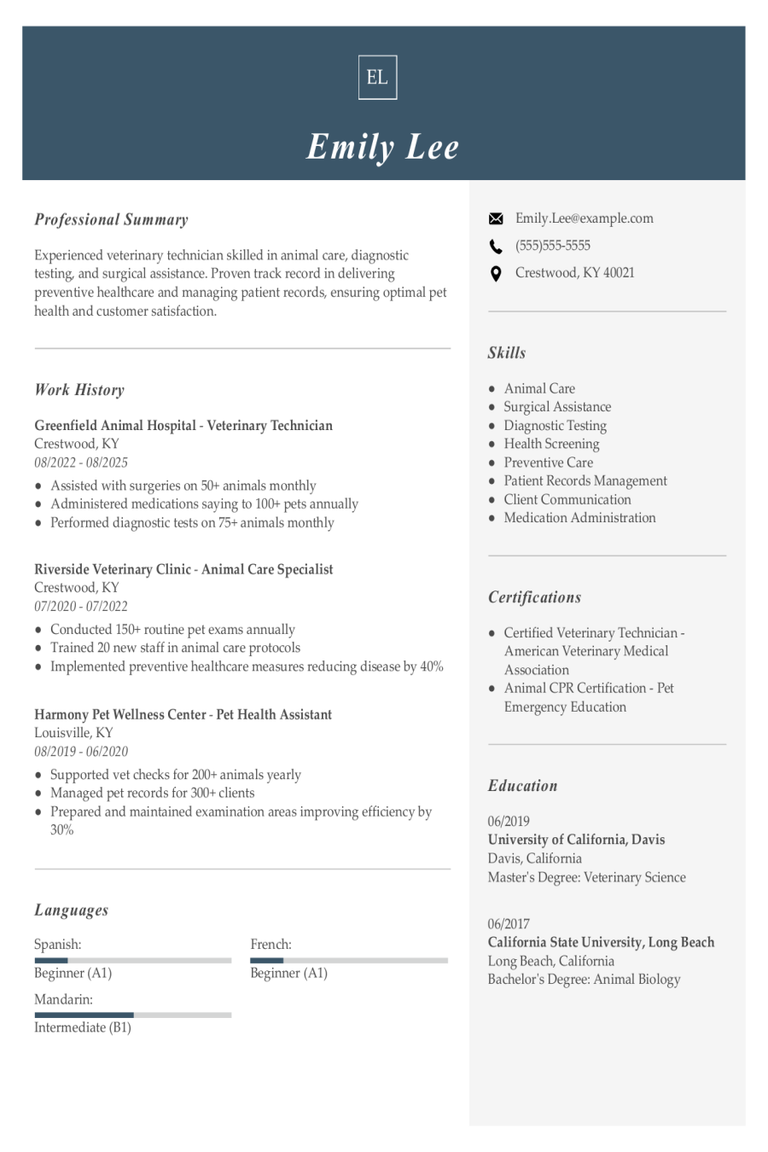
Veterinary Technician Resume Examples & Templates for 2025
Explore veterinary technician resume examples and tips to learn how to showcase your experience caring for animals, assisting vets, and handling lab tests. These samples and tips will help you
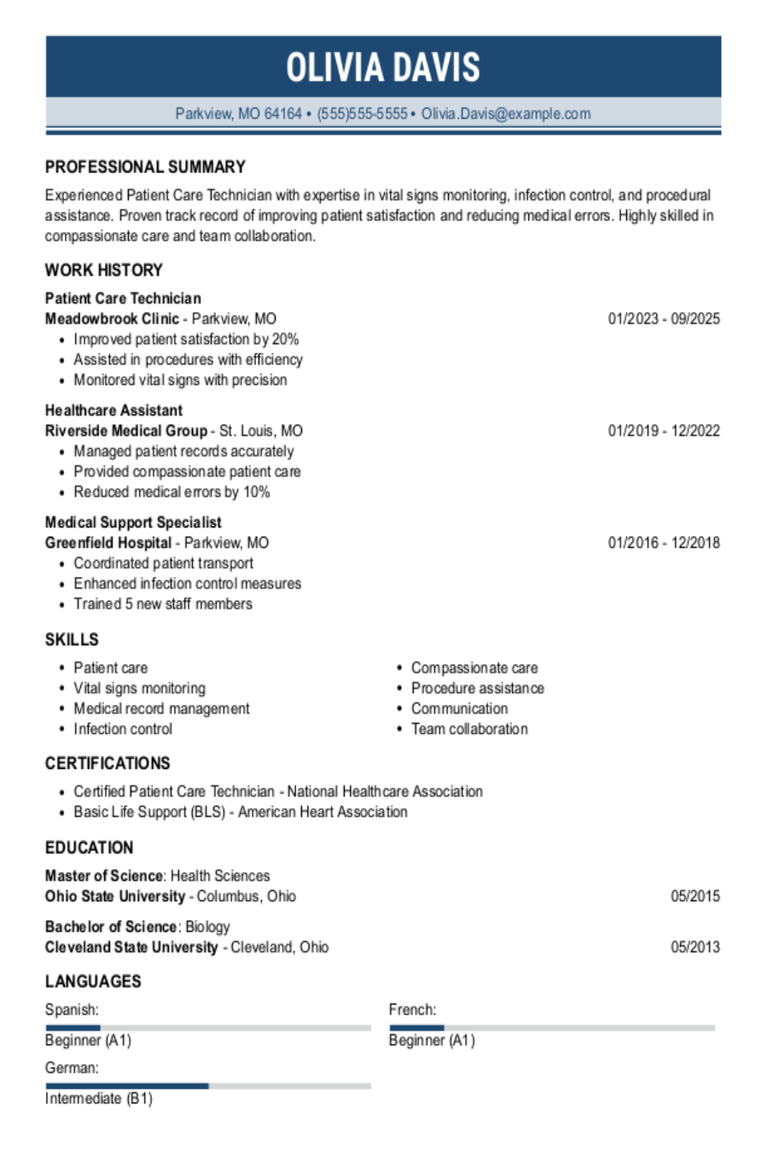
Patient Care Technician Resume Examples & Templates for 2025
Explore patient care technician resume examples to see how to highlight your skills in assisting patients, monitoring vital signs, and supporting medical staff. Discover tips for showcasing your experience in

Quality Control Technician Resume Examples & Templates for 2025
Browse quality control technician resume examples to see how to list your skills in testing and inspection. Discover tips on sharing experiences that demonstrate attention to detail and problem-solving abilities
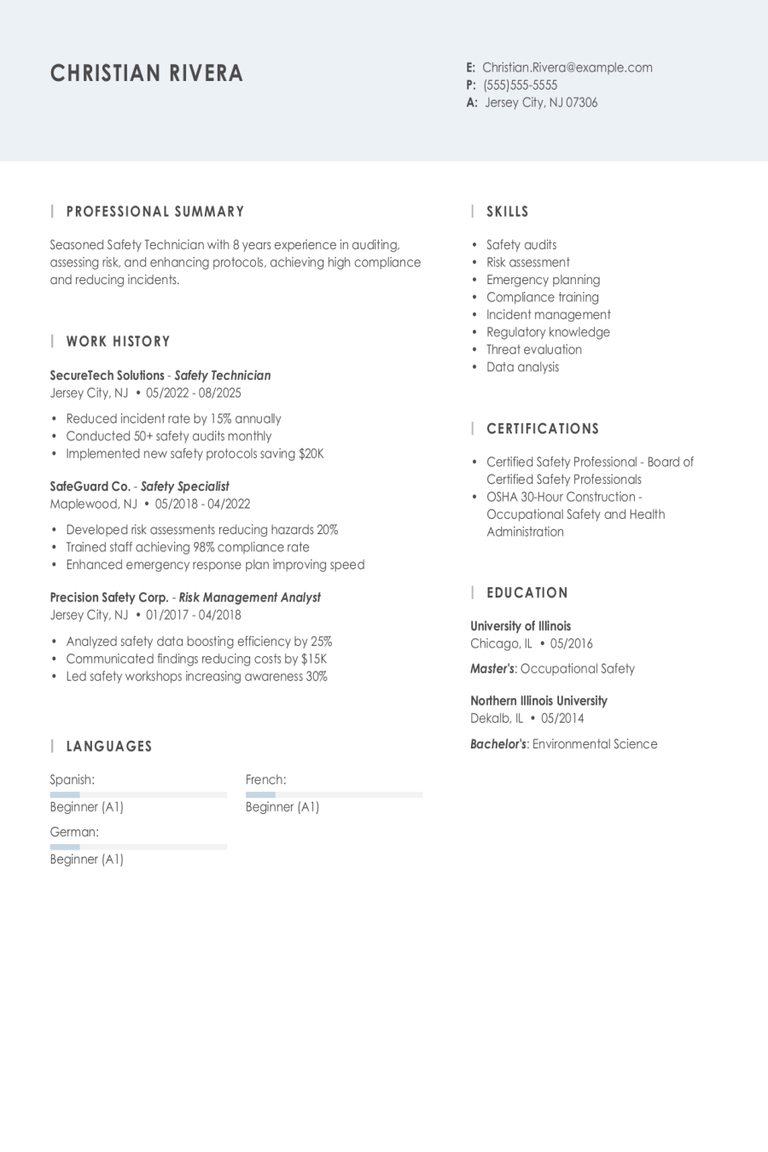
Safety Technician Resume Examples & Templates for 2025
Explore safety technician resume examples that focus on skills like problem-solving, equipment checks, and teamwork. These examples and tips will help you show employers you’re ready to keep workplaces safe
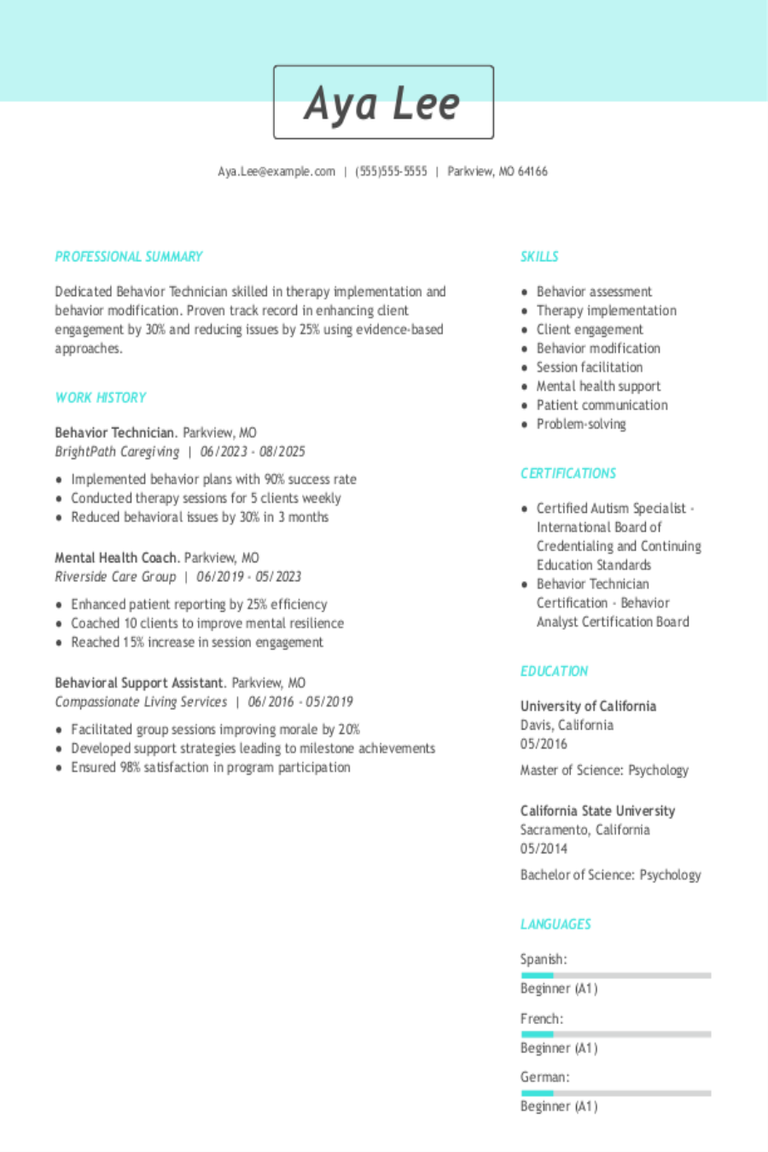
Behavior Technician Resume Examples & Templates for 2025
Discover behavior technician resume examples and learn how to showcase your hands-on experience and make a great impression on potential employers.Build my resumeImport existing resumeCustomize this templateWhy this resume worksQuantifies
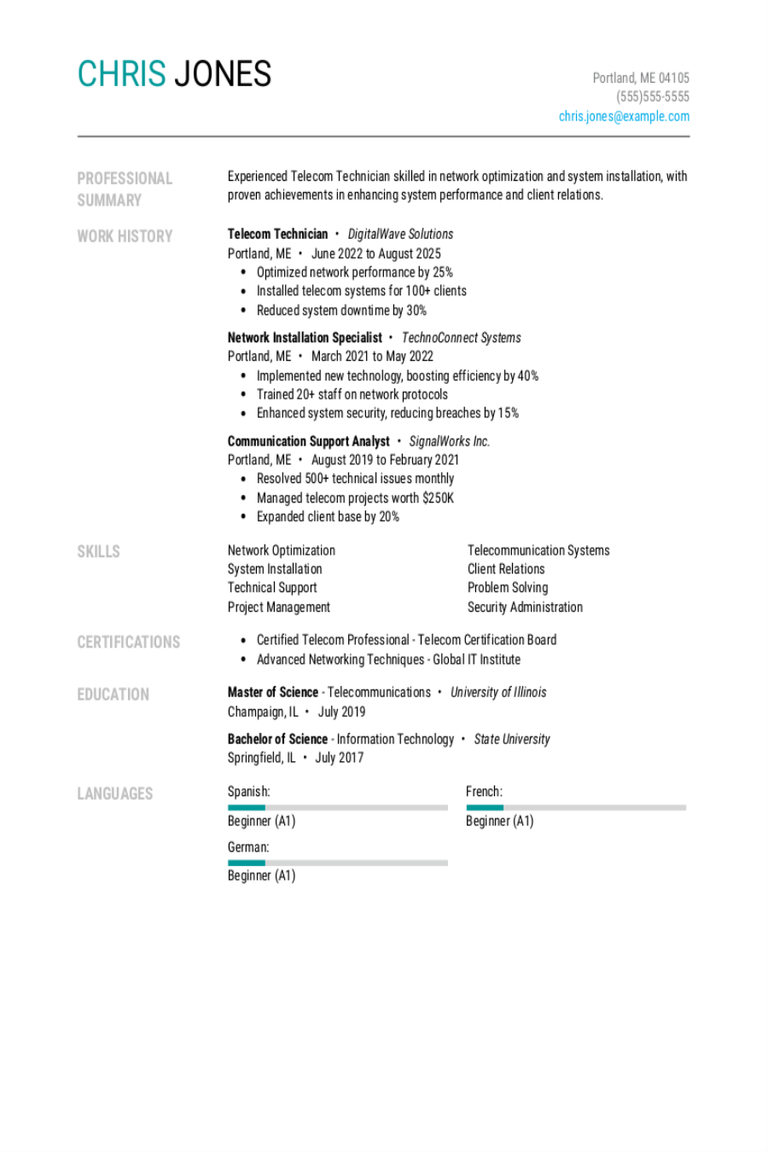
Telecom Technician Resume Examples & Templates for 2025
Browse telecom technician resumes to see how to showcase your experience in fixing and maintaining communication networks, setting up equipment, and solving technical problems. These examples and tips will help
